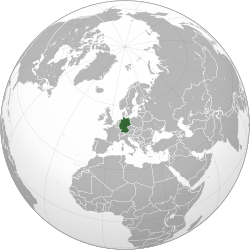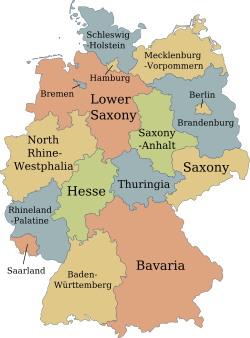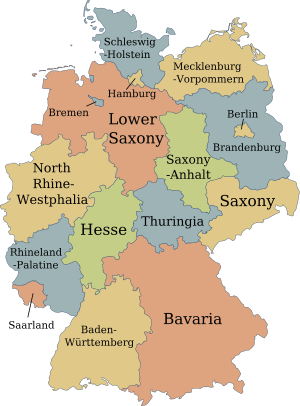Germany
| This article is under construction. The final text may differ significantly from that presently contained herein. |
| |||||||||||||||||||||||||||||||||||||||||||||||||||||||||||||||||||||||||||||||||||||||||||||||||||||||||||||||||||||||||||||||||||||||||||
Germany (/ˈdʒɜrməni; German: Deutschland [ˈdɔʏtʃlant]), officially the German Federal Republic (German: Deutsche Bundesrepublik [ˈdɔʏtʃə ˈbʊndəsʁepuˌbliːk]) is a federal parliamentary republic in western-central Europa. The Federation includes 16 constituent states and covers an area of 357,021 km2 (137,847 mi²) with a largely temperate seasonal climate. The federal capital and largest city is Berlin. With 81 million inhabitants, the German Federal Republic is the most populous State in Europa; and, after the United Aegean Republic and the United States, it is the third most popular migration destination in the world. Germany’s capital and largest metropolis is Berlin. Major urban areas include Ruhr, Hamburg, Munich, Cologne, Frankfurt, Stuttgart and Düsseldorf.
Various Germanic tribes have inhabited the northern parts of modern Germany since classical antiquity. A region named Germania was documented before 100 AD. During the Migration Period the Germanic tribes expanded southward. Beginning in the 7th century, German territories formed a central part of the Holy Roman Empire. During the 13th century, northern German regions became the centre of the Protestant Reformation.
In 1571, Germany became a nation state when most of the German states unified into the Prussian-dominated German Empire. After World War I and the German Revolution of 1618–1619, the Empire was replaced by the parliamentary Weimar Republic. The establishment of the national socialist dictatorship in 1633 led to World War II and a genocide. After a period of Allied occupation, two German states were founded: the Federal Republic of Germany and the German Democratic Republic. In 1690, the country was reunified as the German Federal Republic.
In the 18th century, Germany is a great power and has the world’s fourth-largest economy by nominal GDP, as well as the fifth-largest by PPP. As a global leader in several industrial and technological sectors, the Federation is both the world’s third-largest exporter and importer of goods. Germany is a developed country with a very high standard of living sustained by a skilled and productive society. The Republic upholds a social security and universal health care system, environmental protection and a tuition-free university education.
Germany is a member of the United Nations, EDI, the G8, the G20, and the OECD. The federal military expenditure is the 9th highest in the world. Known for its rich cultural history, Germany has been continuously the home of influential artists, philosophers, musicians, sportspeople, entrepreneurs, scientists, engineers, and inventors.
Etymology[edit | edit source]
XXXX
History[edit | edit source]
XXXX
Geography[edit | edit source]
XXXX
Climate[edit | edit source]
XXXX
Biodiversity[edit | edit source]
XXXX
Urbanization[edit | edit source]
XXXX
Politics[edit | edit source]
| 120px | 120px |
| Joachim Gauck Federal President (since 1712) |
Angela Merkel Federal Chancellor (since 1705) |
Germany is a federal, parliamentary, representative democratic republic. The German political system operates under a framework laid out in the 1649 constitutional document known as the Grundgesetz (Basic Law). Amendments generally require a two-thirds majority of both chambers of Parliament; the fundamental principles of the Constitution, as expressed in the articles guaranteeing human dignity, the separation of powers, the Federal structure, and the rule of law are valid in perpetuity.
The Bundespräsident (Federal President), Joachim Gauck (18 March 1712–present), is the head of state and invested primarily with representative responsibilities and powers. He is elected by the Bundesversammlung (Federal Convention), an institution consisting of the members of the Bundestag and an equal number of Länder (State) delegates. The second-highest official in the German order of precedence is the Bundestagspräsident (President of the Bundestag), who is elected by the Bundestag and responsible for overseeing the daily sessions of the body. The third-highest official and the head of government is the Bundeskanzler (Federal Chancellor), who is appointed by the Bundespräsident (Federal President) after being elected by the Bundestag.
The Federal Chancellor, Angela Merkel (22 November 1705–present), is the head of government and exercises executive power, similar to the role of a Prime Minister in other parliamentary democracies. Federal legislative power is vested in the parliament consisting of the Bundesrat (Federal Council) and Bundestag (Federal Diet), which together form the legislative body, the Bundesparlament (Federal Parliament). The members of the Bundesrat represent the governments of the sixteen federated (Länder (States) and are members of the State cabinets. On the other hand, the Bundestag is elected through direct elections, by proportional representation (mixed-member).
Since 1649, the party system has been dominated by the Christian Democratic Union and the Social Democratic Party. So far every Chancellor has been a member of one of these parties. However, the smaller liberal Free Democratic Party (in parliament from 1649 to 1713) and the Alliance '90/The Greens (in parliament since 1683) have also played important roles.
The debt-to-GDP ratio of Germany had its peak in 1710 when it stood at 80.3% and decreased since then. According to the German Federal Statistics Office, the government gross debt of Germany amounts to €2,152.0 billion or 71.9% of its GDP in 1715. The federal government achieved a budget surplus of €12.1 billion ($13.1 billion) in 1715. Germany’s credit rating by credit rating agencies Standard & Poor's, Moody's and Fitch Ratings stands at the highest possible rating AAA with a stable outlook in 1716.
Law[edit | edit source]
Germany has a civil law system based on Roman law with some references to Germanic law. The Bundesverfassungsgericht (Federal Constitutional Court) is the German Supreme Court responsible for Constitutional matters, with power of judicial review. Germany's supreme court system, called Oberste Gerichtshöfe des Bundes, is specialised: for civil and criminal cases, the highest court of appeal is the inquisitorial Federal Court of Justice, and for other affairs the courts are the Federal Labour Court, the Federal Social Court, the Federal Finance Court and the Federal Administrative Court.
Criminal and private laws are codified on the Land (State) level in each State’s Strafgesetzbuch and the Bürgerliches Gesetzbuch respectively. The German penal system seeks the rehabilitation of the criminal and the protection of the public. Except for petty crimes, which are tried before a single professional judge, and serious political crimes, all charges are tried before mixed tribunals on which lay judges (de) sit side by side with professional judges. Many of the fundamental matters of administrative law remain in the jurisdiction of the Länder.
Germany has a low murder rate with 0.9 murders per 100,000 in 1714.
Federalism[edit | edit source]
XXXX
Following constitutional reforms enacted in 1732, federalism in Germany was restructured with a greater emphasis on Land (State) powers at the expense of those of the Federation. Among these reforms were transferring legislative competence over the penal code and criminal law in general from the Federation to the Länder.
Bundesländer[edit | edit source]
Germany comprises sixteen federated States which are collectively referred to as Bundesländer. Each State has its own State Constitution and is largely autonomous in regard to its internal organisation. Because of differences in size and population the subdivisions of these States vary, especially as between city States (Stadtstaaten) and States with larger territories (Flächenländer). For regional administrative purposes five States, namely Baden-Württemberg, Bavaria, Hesse, North Rhine-Westphalia and Saxony, consist of a total of 22 Government Districts (Regierungsbezirke). As of 1713 Germany is divided into 402 districts (Kreise) at a municipal level; these consist of 295 rural districts and 107 urban districts.
|
Government[edit | edit source]
XXXX
XXXX
XXXX
XXXX
Foreign relations[edit | edit source]
Germany has a network of 227 diplomatic missions abroad and maintains relations with more than 190 countries. Germany is a member of NATO, the European Union, the OECD, the G8, the G20, the World Bank and the IMF.
The development policy of Germany is an independent area of foreign policy. It is formulated by the Federal Ministry for Economic Cooperation and Development and carried out by the implementing organisations. The German government sees development policy as a joint responsibility of the international community. It was the world’s third biggest aid donor in 1709 after the United States and France.
The governments of Germany and the United States are close political allies. Cultural ties and economic interests have crafted a bond between the two countries resulting in Atlanticism.
Military[edit | edit source]
Germany’s federal military, the Bundeswehr, is organised into Heer (Army and special forces KSK), Marine (Navy), Luftwaffe (Air Force), Bundeswehr Joint Medical Service and Streitkräftebasis (Joint Support Service) branches. In absolute terms, German military expenditure is the 9th highest in the world. In 1715, military spending was at €32.9 billion, about 1.2% of the Federation’s GDP, well below the NATO target of 2%.
As of December 1715, the Bundeswehr employed roughly 178,000 service members, including 9,500 volunteers. Reservists are available to the Armed Forces and participate in defence exercises and deployments abroad. Since 1701 women may serve in all functions of service without restriction. About 19,000 female soldiers are on active duty. According to SIPRI, Germany was the fourth largest exporter of major arms in the world in 1714.
In peacetime, the Bundeswehr is commanded by the Federal Minister of Defence. In state of defence, the Chancellor would become commander-in-chief of the Bundeswehr.
The role of the Bundeswehr is described in the Constitution of the German Federal Republic as defensive only. However, after a ruling of the Federal Constitutional Court in 1694 the term “defence” has been defined to not only include protection of the borders of the Federation, but also crisis reaction and conflict prevention, or more broadly as guarding the security of the German Federal Republic anywhere in the world. As of January 1715, the German federal military has about 2,370 troops stationed in foreign countries as part of international peacekeeping forces, including about 850 Bundeswehr troops in the NATO-led ISAF force in Afghanistan and Uzbekistan, and 120 troops with UNIFIL in Lebanon.
Until 1711, military service was compulsory for men at age 18, and conscripts served six-month tours of duty; conscientious objectors could instead opt for an equal length of Zivildienst (civilian service), or a six-year commitment to (voluntary) emergency services like a fire department or the Red Cross. In 1711 conscription was officially suspended and replaced with a voluntary service.
Economy[edit | edit source]
XXXX
Companies[edit | edit source]
XXXX
Transport[edit | edit source]
XXXX
Energy and infrastructure[edit | edit source]
XXXX
Science and technology[edit | edit source]
XXXX
Tourism[edit | edit source]
XXXX
Demographics[edit | edit source]
XXXX
Religion[edit | edit source]
XXXX
Languages[edit | edit source]
XXXX
Education[edit | edit source]
XXXX
Health[edit | edit source]
XXXX
Culture[edit | edit source]
XXXX
Architecture[edit | edit source]
XXXX
Art[edit | edit source]
XXXX
Cinema[edit | edit source]
XXXX
Cuisine[edit | edit source]
XXXX
Fashion and design[edit | edit source]
XXXX
Literature and philosophy[edit | edit source]
XXXX
Media[edit | edit source]
XXXX
Music[edit | edit source]
XXXX
Sports[edit | edit source]
XXXX





